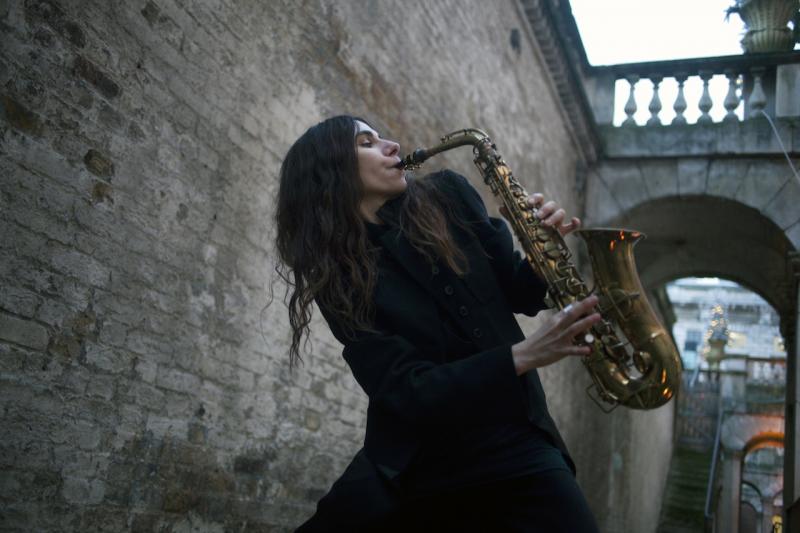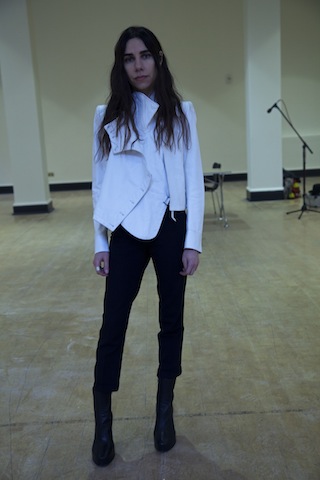PJ Harvey: Recording in Progress, Artangel at Somerset House | reviews, news & interviews
PJ Harvey: Recording in Progress, Artangel at Somerset House
PJ Harvey: Recording in Progress, Artangel at Somerset House
The musician in full creative swing: a voyeur’s delight

Artangel continues to instigate extraordinary events in extraordinary places. Over the past two decades and more, directors Michael Morris and James Lingwood have helped generate major and ground-breaking work by Rachel Whiteread, Brian Eno, Laurie Anderson, Roni Horn, Jeremy Deller, Steve McQueen, Matthew Barney, Gregor Schneider, Francis Alÿs and many others. It's a long list.
Artangel has always excelled at finding new uses for abandoned buildings, or at reinventing existing ones, knowing that this displacement, resolutely outside the comfort zone of the white cube, takes art beyond the acts of rebellion that have repetitively followed Duchamp’s radical presentation of the readymade urinal. Artangel’s constant relocation of art and the artistic gesture encourages the imagination to take flight, something not always possible in galleries and museums.
The visit to “Recording in Progress” takes a small group deep down a maze of corridors and staircases into the bowels of Somerset House. This short journey, which feels both mundane and initiatory, leads to the former Inland Revenue gymnasium and rifle range, now housing a purpose-built recording studio in which visitors can observe Harvey, her producers and fellow-musicians working on a new album. There are large windows on two sides of an enclosed space with the air of a large (waterless) aquarium. The musicians can’t see the spectators. The effect is startling, as there is, in spite of the soundproof double-glazing, an instant and surprisingly intimate feeling of connection. Polly and her recording companions are all wearing radio mics, so we can hear everything they say with great clarity.
It's impossible not to feel as if we are watching animals in a zoo
PJ Harvey has talked in an interview with Michael Morris about the installation being a kind of sculpture. This makes sense in terms of the carefully arranged setting – at once familiar and awe-inspiring: the tools of the trade that make up Harvey’s increasingly sophisticated musical world, every breed of saxophone from soprano to baritone, a fluegelhorn, a bass clarinet, two auto-harps, various drums and percussion instruments, a rickety-looking upright piano, an accordion, a battery of guitars and an exotic hurdy-gurdy.
There is a powerful documentary element to the experience: we watch the unfolding of the recording process, albeit only for the 45 minutes allotted to each visit. We become flies-on-the-wall, watching every move and the many-faceted interactions between the characters in what feels like a clip from a more or less genre-based rock’n’roll soap opera – the making of an album in the studio. There are moments when everyone is silent, deep in thought or perhaps just bored, and others when the pace changes: John Parish, long-time collaborator and producer, proposes a reggae rhythm for the song they are working on. His co-producer Flood gently steers things in another direction. His subtle command of the situation, given Harvey’s reputation as a woman with a very strong sense of what she wants, is impressive. He’s clearly very good at what he does, and knows how to conjure sounds that resonate with the movement of Polly’s creative soul.
 They are working on the drum sound and Flood plugs the tom-tom mics into a gizmo that produces a dub-like reverb, transforming the sonorous thud into something at once cavernous and ethereal. The song begins to take root, grounded in the magic and mystery that Flood has coaxed out of a few electronic toys. “It’s a whole different universe!” Polly exclaims in wonder, taking up her guitar and starting to sing. A moment that zings – a visceral excitement animates the studio and is instantly transmitted as if by contagion through the glass. Flood responds by asking the engineer to “do a take”. In a flash, the genesis of the inspired soundscapes that graced her most recent album Let England Shake, a musical setting that continually challenged the clichés of rock while remaining totally appropriate to the feel of the songs, becomes crystal-clear. There is an openness about the recording process here that allows risk at every moment and encourages intuitive leaps and serendipity. Watching from behind the glass, the excitement is shared in a quasi-miraculous way. It hardly matters that we are only witnessing a brief moment: the essence is tangible.
They are working on the drum sound and Flood plugs the tom-tom mics into a gizmo that produces a dub-like reverb, transforming the sonorous thud into something at once cavernous and ethereal. The song begins to take root, grounded in the magic and mystery that Flood has coaxed out of a few electronic toys. “It’s a whole different universe!” Polly exclaims in wonder, taking up her guitar and starting to sing. A moment that zings – a visceral excitement animates the studio and is instantly transmitted as if by contagion through the glass. Flood responds by asking the engineer to “do a take”. In a flash, the genesis of the inspired soundscapes that graced her most recent album Let England Shake, a musical setting that continually challenged the clichés of rock while remaining totally appropriate to the feel of the songs, becomes crystal-clear. There is an openness about the recording process here that allows risk at every moment and encourages intuitive leaps and serendipity. Watching from behind the glass, the excitement is shared in a quasi-miraculous way. It hardly matters that we are only witnessing a brief moment: the essence is tangible.
But, this is not all, as the installation challenges us in other ways: it's impossible not to feel as if we are watching animals in a zoo, slightly impatient when the caged beasts are a bit sleepy, and wanting our money’s worth of movement, change, drama, or at least the unfolding of a story, the way we have been led to expect by film, TV, and other forms of fiction. Slow-moving unedited reality isn’t soap opera, and yet, because of the demands it puts on our patience, asking us to slow down and let go of expectations, this waiting and paying attention is considerably more rewarding. By challenging our voyeuristic tendencies – we are watching, after all, one of Britain’s most formidable musical artists at work – and undermining our desire for theatrical behaviour, the "installation" encourages reflection.
Besides, as the protagonists in this piece of performance art know they are being closely observed – the visits are carefully scheduled – there is a probably well-founded suspicion that they are putting on something of an act, just as the spider monkeys do at the zoo, even though we are invisible through the glass. The 45 minutes I witnessed had a feeling of perfect story-telling, with a slow rise in the creative temperature, climaxing in a moment of musical grace. As a documentary film-maker, I know from experience that the people I film (many of them professional performers, like PJ Harvey and her team) rise to the occasion and instinctively deliver a well-honed script the moment I switch the camera on.
All of this adds to the richness and layering of “Recording in Progress”. The gentle explosion of expectations, accompanied by a sense of wonder, is characteristic of Artangel, who consistently find subtle ways of undermining our take on what makes art, or on how and where we should be experiencing it.
- Recording in Progress is sold out but further details on Artangel's website
Explore topics
Share this article
Add comment
The future of Arts Journalism
You can stop theartsdesk.com closing!
We urgently need financing to survive. Our fundraising drive has thus far raised £49,000 but we need to reach £100,000 or we will be forced to close. Please contribute here: https://gofund.me/c3f6033d
And if you can forward this information to anyone who might assist, we’d be grateful.

Subscribe to theartsdesk.com
Thank you for continuing to read our work on theartsdesk.com. For unlimited access to every article in its entirety, including our archive of more than 15,000 pieces, we're asking for £5 per month or £40 per year. We feel it's a very good deal, and hope you do too.
To take a subscription now simply click here.
And if you're looking for that extra gift for a friend or family member, why not treat them to a theartsdesk.com gift subscription?

Comments
Oh well Mark you make it all